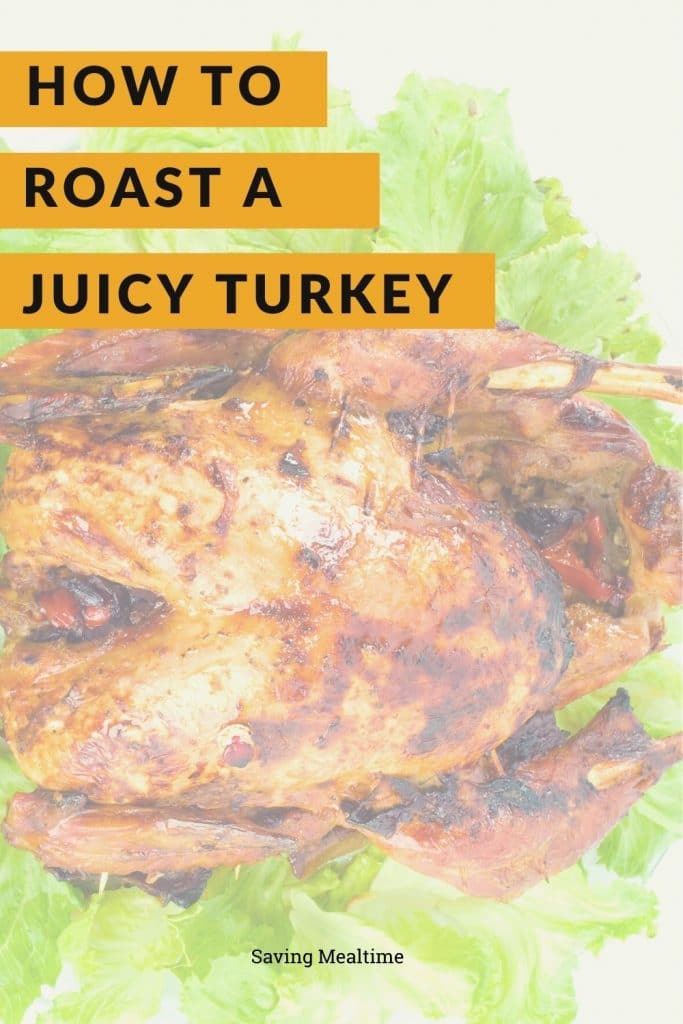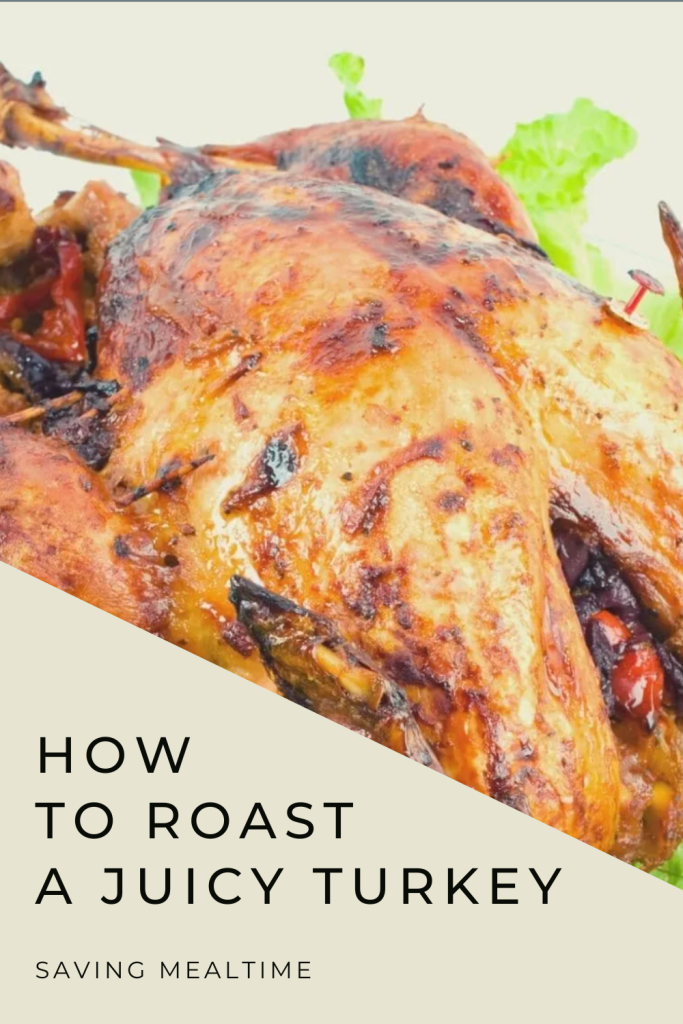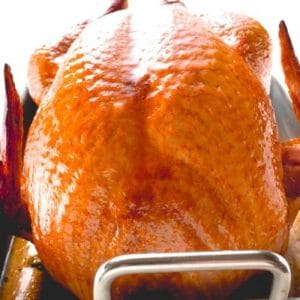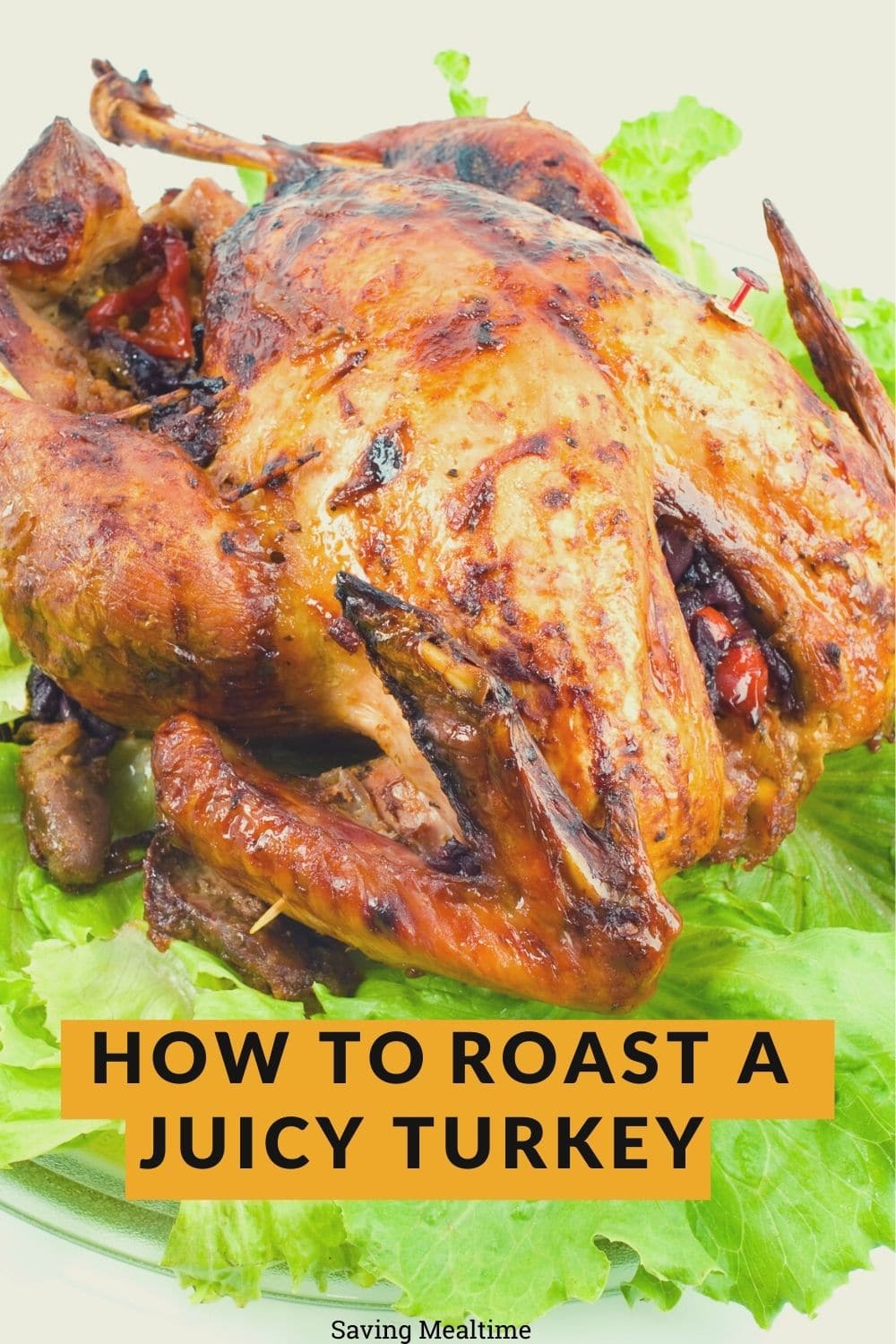Roasting a juicy turkey is a culinary art that results in a flavorful and succulent centerpiece for your holiday feast. As the turkey slowly cooks in the oven, the skin crisps up to a beautiful golden brown, while the meat inside remains tender and moist. The aroma of the roasting turkey fills the kitchen, creating an inviting and festive atmosphere.
Jump to:
With each bite, you experience a perfect balance of flavors. The seasoning mixture of salt, pepper, herbs, and spices permeates the turkey, enhancing its natural taste. The moist meat boasts a delicate texture that practically melts in your mouth. The white meat is tender and juicy, while the dark meat is rich and full of savory goodness.
The carefully roasted turkey showcases its culinary journey, promising a memorable dining experience. The outside is adorned with a glistening and crispy skin that offers a satisfying crunch when bitten into. Slicing into the turkey reveals beautifully cooked slices of meat, ready to be enjoyed.
The juices released during the cooking process create a delectable gravy that complements the turkey perfectly. When poured over the slices, it adds an extra layer of richness and flavor, elevating the taste to new heights.
As you savor each bite of the juicy roasted turkey, the flavors come together harmoniously, leaving a lasting impression. The combination of seasoned skin, moist meat, and aromatic herbs creates a symphony of tastes that celebrates the essence of a well-roasted turkey.
Roasting a juicy turkey requires time, care, and attention to detail, but the result is worth every effort. It's a culinary masterpiece that brings loved ones together, creating lasting memories and a sense of gratitude. The juicy roasted turkey truly embodies the spirit of a festive and satisfying meal.

How big of a turkey do I need?
The rule of thumb is to buy 1 to 1 ½ pounds of turkey for each guest.
How long should a turkey be roasted per pound?
Generally, a turkey should be roasted for approximately 13 to 15 minutes per pound at a temperature of 325°F (165°C). However, it's important to note that this is just an estimate, and the actual roasting time may vary based on several factors such as the size of the turkey, whether it's stuffed or unstuffed, and the accuracy of your oven's temperature.
Here's a breakdown of the estimated roasting times for different turkey sizes:
- 10 to 12 pounds: Approximately 2.5 to 3 hours
- 12 to 14 pounds: Approximately 3 to 3.75 hours
- 14 to 18 pounds: Approximately 3.75 to 4.5 hours
- 18 to 20 pounds: Approximately 4.5 to 5 hours
- 20 to 24 pounds: Approximately 5 to 5.5 hours
It's important to monitor the turkey's internal temperature using a meat thermometer to ensure it reaches a safe temperature. The turkey is considered fully cooked when the internal temperature reaches 165°F (74°C) in the thickest part of the thigh without touching the bone. The temperature in the breast should be around 160°F (71°C).
How long should Roasted Turkey rest?
After roasting a turkey, it's essential to let it rest before carving. This resting period allows the juices to redistribute within the meat, resulting in a more tender and flavorful turkey. As a general rule, a roasted turkey should rest for about 20 to 30 minutes. However, the exact time can vary depending on the size of the turkey and personal preference.
During the resting period, you can tent the turkey loosely with foil to help retain its warmth. This will also prevent excessive heat loss, allowing the turkey to cool slightly. The resting time gives you an opportunity to prepare any accompanying dishes, make gravy, or allow the turkey to settle before carving.
Resting the turkey is crucial to ensure the meat remains juicy and the flavors are well-distributed. It also makes the carving process easier as the meat will be firmer and easier to handle.
Remember to take into account the overall timing of your meal preparation. If you need to keep the turkey warm for an extended period, you can loosely tent it with foil and place it in a warm oven (set at a low temperature, around 200°F or 95°C) while still monitoring the internal temperature to avoid overcooking.
Allowing your roasted turkey to rest will reward you with a delicious, tender, and flavorful centerpiece for your holiday feast.

How to Safely Thaw a Frozen Turkey
Thawing a frozen turkey safely is important to ensure that it remains free from harmful bacteria and reaches the desired level of doneness when cooked. There are three recommended methods for safely thawing a frozen turkey: refrigerator thawing, cold water thawing, and microwave thawing. Here's a guide for each method:
- Refrigerator Thawing:
- Place the frozen turkey on a tray or in a shallow pan to catch any drips.
- Keep the turkey in its original packaging or place it in a leak-proof plastic bag to prevent any cross-contamination.
- Place the turkey in the refrigerator on the lowest shelf or in a cooler set to maintain a temperature of 40°F (4°C) or below.
- Allow approximately 24 hours of thawing time for every 4 to 5 pounds (1.8 to 2.3 kg) of turkey. For example, a 12-pound (5.4 kg) turkey will take about 3 days to thaw completely.
- Once thawed, keep the turkey in the refrigerator for up to 2 days before cooking.
- Cold Water Thawing:
- Ensure the turkey is adequately packaged with no leaks. If needed, place it in a leak-proof plastic bag.
- Fill a clean sink or a large container with cold water. Submerge the turkey in the water, breast side down.
- Change the water every 30 minutes to maintain a consistently cold temperature.
- Allow about 30 minutes of thawing time per pound (0.45 kg) of turkey. For example, a 12-pound (5.4 kg) turkey will take about 6 hours to thaw using this method.
- Once thawed, cook the turkey immediately. Do not refreeze.
- Microwave Thawing:
- Check your microwave's manual for specific instructions on thawing a turkey.
- Ensure the turkey is microwave-safe, and follow the manufacturer's guidelines for weight and time settings.
- Remove all packaging materials and place the turkey on a microwave-safe dish or tray.
- Use the microwaves defrost setting or low power setting to thaw the turkey.
- Monitor the turkey closely to prevent any part from starting to cook. It's essential to cook the turkey immediately after microwave thawing.
Regardless of the method you choose, always follow proper food safety practices. Thawing a turkey at room temperature is not recommended as it can allow the surface of the turkey to enter the temperature danger zone (40°F to 140°F or 4°C to 60°C), promoting bacterial growth.
Once the turkey is fully thawed, you can proceed with your preferred cooking method, such as roasting, to prepare a delicious and safely cooked turkey.
Items That Pair Well With Turkey:
When it comes to pairing dishes with turkey, there are numerous options to complement its flavors and create a well-rounded meal. Here are some popular items that pair well with turkey:
- Gravy: A classic accompaniment, homemade gravy made from the turkey drippings adds richness and enhances the flavors of both the turkey and other side dishes.
- Cranberry Sauce: The sweet and tangy flavors of cranberry sauce contrast the savory turkey. It adds a burst of freshness to the meal.
- Stuffing/Dressing: Whether it's traditional bread-based stuffing or a flavorful dressing with various ingredients like herbs, vegetables, or nuts, it complements the turkey and adds texture and flavor to the meal.
- Mashed Potatoes: Creamy, buttery mashed potatoes are a staple side dish that pairs perfectly with turkey. They provide a comforting and smooth contrast to the meat.
- Roasted Vegetables: Roasting vegetables like carrots, Brussels sprouts, green beans, or butternut squash brings out their natural sweetness and adds a beautiful pop of color to the plate.
- Sweet Potatoes: Sweet potato casserole, mashed sweet potatoes, or roasted sweet potato wedges are deliciously sweet options that provide a balance of flavors alongside the turkey.
- Green Bean Casserole: A classic side dish made with green beans, creamy mushroom sauce, and crispy fried onions. It adds a comforting and flavorful element to the meal.
- Cornbread: Cornbread or cornbread stuffing complements the flavors of turkey and adds a Southern touch to the meal.
- Brussels Sprouts: Roasted Brussels sprouts, when cooked until crispy and caramelized, offer a delightful balance of flavors and textures with the turkey.
- Asparagus: Grilled asparagus spears, lightly seasoned and cooked until tender, make for an elegant and healthy side dish that pairs well with turkey.
- Dinner Rolls: Soft, warm dinner rolls are a great addition to any Thanksgiving or holiday table, allowing you to make mini turkey sandwiches or enjoy them with a dab of butter.
- Salad: A refreshing salad with mixed greens, cranberries, pecans, goat cheese, or feta cheese adds a light and vibrant component to the meal.
These are just a few ideas, and the choices for pairing side dishes with turkey are virtually endless. Consider your preferences and any traditional or family favorites when planning your menu.

Roasting a Turkey
Equipment
Ingredients
- 1 stick Butter
- 16-18 lb Turkey
Instructions
- Preheat the oven to 350 degrees
- Take the giblets out of the turkey and wash the turkey inside and out. Remove any excess fat and leftover pinfeathers and pat the outside dry. Place the turkey in a large roasting pan.
- Using ¾ of the stick of butter, cut approximately ⅛inch sections.
- Using a spoon lift the skin on the turkey and stuff some butter all around.
- With the remaining ¼ of butter use it to rub all around the skin of the turkey.
- Tie the legs together with string and tuck the wing tips under the body of the turkey.
- Roast the turkey for about 3 to 3 ½ hours, or until the juices run clear when you cut between the leg and the thigh.
- Remove the turkey to a cutting board and cover with aluminum foil. Let rest for 15-30 minutes before cutting and serving







Leave a Reply